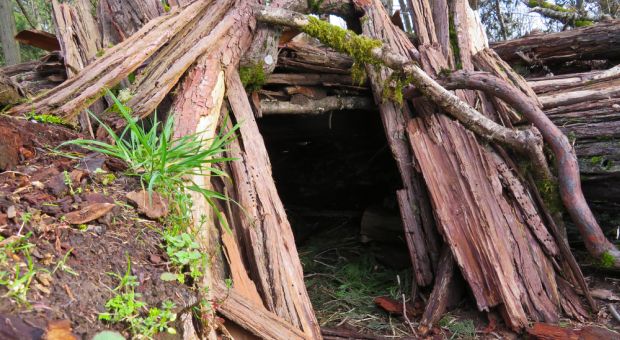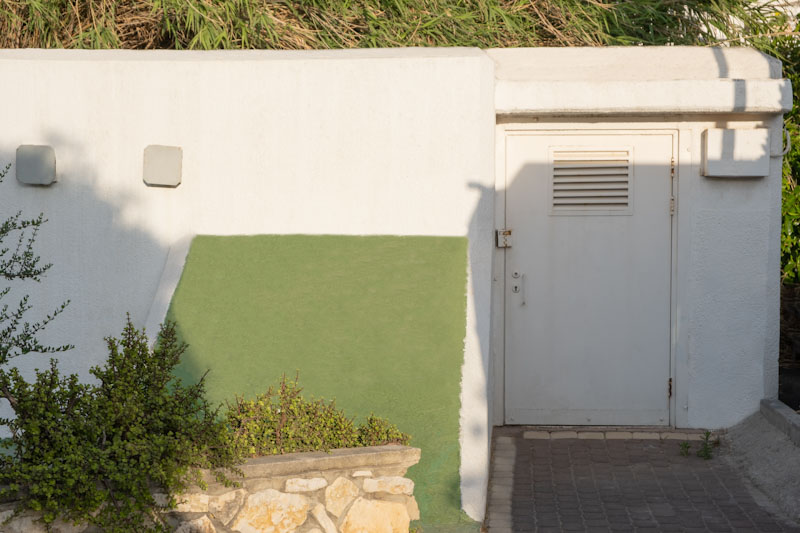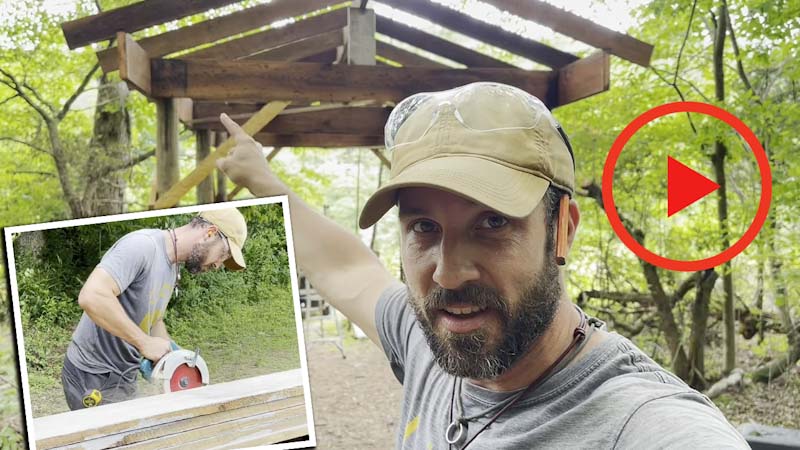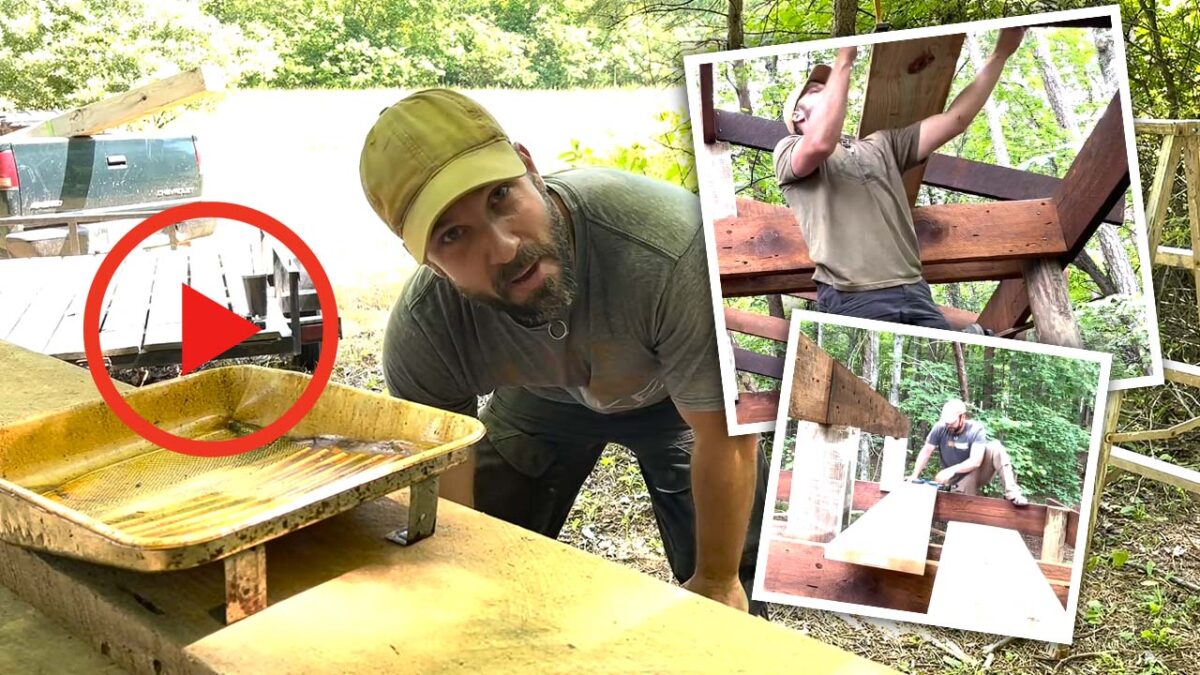The U.S. Congress knows our electrical grid is America’s Achilles Heel and there’s an avalanche of evidence that our electrical network is more vulnerable than commercial jets before 9/11.
Plus there are countless of other scenarios beside a long-term national blackout that could lead to the exact same situation. That’s why I want you to think about this and dedicate every bit of his energy to ensuring your family is well taken care of so you can rest assured knowing their safety and well-being are in good hands: What would it do to your confidence to have a special forces operator as your personal outdoor survival guide for when America descends into chaos and anarchy?
Catch A Glimpse of Green Beret Outdoor Survival Ingenuity
My name is Bob and my childhood was all about getting as many Boy Scout Merit Badges as I could. Perhaps you remember the good ol’ days. I pride myself as being better equipped to deal with real-life survival situations than 99% of US citizens… That was until I decided to test 3 of the most important outdoor survival skills in a disaster scenario. The skills were: fire craft, shelter building and water procurement.
To make things more interesting, retired Master Sergeant Brian Morris – a former member of the US Special Forces joined me that I met at a wilderness survival conference.
Now I’d been to plenty other conferences before, but up until I saw Brian’s presentation, I never once felt like I learned something I hadn’t heard of before at least a dozen times… something that for once seemed like ‘next-level’ info. I felt like Brian was someone who was willing to reveal the know-how everyone else wasn’t or perhaps that nobody else knew of. So, at the end of one of his presentations, I introduced myself, thanked him for his presentation and asked him if he’d like to join me for dinner where I planned on digging even deeper… if possible.
Over that dinner I got to know more about Brian’s history with the Special Forces.
And during the 2 decades he spent in the Special Forces, Brian fought in the most extreme environments, from the driest and hottest desert with the most infertile soil and fiercest sun, to snow and ice-covered mountains where temperatures rarely went above freezing. And that’s not to mention hot, rainy, sweaty, muggy and insect-infested hellholes.
As it turned out, he lived at a 2-hour drive away from me and that gave me the perfect opportunity to challenge his Special Forces survival methods to a clash between my ‘civilian’ ones. I told him about my imagined scenario: stranded in the wilderness, no food nor water, with nothing but our knives and a few resources from our backpack. I told him I wanted to see for myself how someone with his background approaches the challenges of a survival situation.
Brian gladly accepted my challenge, and one month after our dinner, we were in the woods, tackling my imagined scenario.
Our first order of business: SHELTER.
We both needed to find a good spot to set camp. When picking one, you need to consider your surroundings: have you got lots of deadfall? Are you in an area that’s sheltered in general? If you’re out in an open field, there’s not going to be much shelter. It’s best to find those areas that are really dense, and somehow naturally protected. We wandered around for a bit to see what we could find. Now, there had been a big storm in the area, and some trees had their roots blown over. Brian immediately saw that as an opportunity.
The blown over root formed a natural wall… so we had almost half the shelter without having to raise a finger. And in a survival situation, you want to spare every single drop of energy you can. For the rest of the shelter structure, Brian went for a simple ‘A’ frame.
I went out to look a log for the ridgeline, while Brian started gathering moss and some smaller logs to make that ‘A’ part of the actual shelter. Brian told me that the longer the log, the more room we would have inside.
The general rule for one person is to find a log that’s about 4 feet longer than the size of that person’s body. Once we had our ridgeline, we carefully laid down the smaller branches onto each side… We insulated it adding the moss and it’s done.
Now that we had shelter, we needed to start a fire.
And this is where things got interesting… That’s because we decided to get a contest to see who could start one faster. And while I decided to muscle up and go for the hand-drill method. Brian’s approach revealed his Special Forces ingenuity as he started a fire, in less than 5 minutes by using his pee. Yes, you heard that right.
First, he collected his urine in a zip-lock plastic bag he had in his backpack.
Then, he found an opening in the tree-line where the sun was shining all the time.
Next, he took his urine filled ziplock, tightened it to form a little liquid pouch and used it as a ‘magnifying glass’ on some birch tree bark… and soon enough he had a self-sustaining ember to which he added some layers of grass and leaves… And he had a fire.
Meanwhile, I was sweating bullets trying to rub one piece of wood onto another…
Head-to-head for water procurement
Having the lesson of redundancy fresh in my mind, I decided to keep my options open and come up with a plan B. My first idea of water procurement was to dig a Gypsy Well. In layman’s terms, it’s a hole dug to collect water. But you can’t just dig anywhere. Typically, you dig where you know the water table is just below ground level.
I remembered that when looking for our camp spot, I saw a small plateau of peat which I noticed was particularly wet… I thought that was a good place to test my skill. I used my hands and knife to dig out a hole about one foot deep and I was lucky enough to see the well starting to slowly fill up. Of course, the water needed filtering or boiling, but that was no problem as we had a fire going back at camp. If this wouldn’t have worked, plan B would have probably been a solar still. I was eager to brag to Brian about my accomplishment and to find out what he was up to.
Imagine the look on my face when I saw him lying on his back resting comfortably by the fire doing absolutely nothing… and with no water in sight. I thought maybe he’d forgotten about this third challenge. He hadn’t. He just saw an opportunity to get clean, fresh drinking water without raising as much as a finger.
Here’s what he’d done while I was out digging…
He put some clean rags he had in his backpack on the moss roof of our shelter. He knew that, as night fell, condensation would soak the rags, giving us enough water for the next day. Plus, it was 100% pure and ready to drink. No boiling or filtration needed. And no more energy wasted.
Master Sergeant Brian Morris was getting almost annoying. I could not help but feel that he would have absolutely no problem of making the wilderness his second home.
The biggest difference I saw between Brian’s skill and mine was this:
I was more than competent but everything I did required way more work, took more time and drained more energy. Brian’s methods were faultless and virtually effortless. And in life or death scenarios, the less time, energy, and effort you waste, the more you boost your chances of survival. And now more than ever, I felt like I was light-years away from that…
I felt there were so many things I needed to learn…
Unfortunately, we were running short on time, so I only got to ask him about what sets Special Forces Operators apart from everyone else. His answer was simple: it’s the consequences. The more he talked, the more I was in awe of this man’s wisdom. Having him alongside me in this imaginary disaster scenario made felt like having an all-knowledgeable bush craft and wilderness survival Codex at my disposal.
Unfortunately, our time together was coming to an end and there was only so much that I could learn from just one day spent together…












Judge Holden | April 30, 2019
|
Really, how much water did you get out of those rags? I call BS…this reminds of a Gomer Pyle episode where Sgt Carter and Gomer are paired in a survival exercise. The Sarge does everything the hard way, Gomer is a country boy and has them eating rainbow trout and rabbit stew, drinking crystal clean spring water, and gaining so much weight during the exercise that they are failed!
Susan Harris | May 2, 2019
|
Spiration takes very little effort as well.
Susan Harris | May 2, 2019
|
that was supposed to read transpiration! Sorry
Sarah | September 14, 2019
|
I’m just a woodsy back country kid, now an adult in my 50’s, and most certainly not what one would call a survivalist, but I am sure puzzled by all the people who think the “survivalist’s way” to start a fire is with the calorie burning, strength ebbing efforts of creating enough friction between two pieces of wood to start a fire! The sunlight through pee going to work, it is the same thing as using a magnifying glass in the sun to do the same job, but having to rely on using pee is less cleanly. With a magnifying glass once can start a fire most anywhere, even in the dark. I’ve done so several times as a kid continuing through my latter 30’s when in the woods. One of my standard backpacking pieces of equipment was a magnifying glass. A good bright flashlight held at the right angle against the magnifying glass has started many a fire in a nicely controlled space for me, much less my parents who taught me and my siblings, who were taught by their forefathers. What happened to lose that piece of fire starting knowledge? It doesn’t take that long with the sun, a little longer with a bright flashlight, but it sure takes a lot less energy and strength than the macho rubbing of two sticks together method. I’ve watched my grandfather use the shiny side of aluminum foil to start fires using the sun just as easily as a magnifying glass. Since magnifying glasses come in all sizes, and a small glass in a little case take up very little room in either a backpack, pocket or fanny pack, I sure can’t see not carrying one. I used it as a last resort when other faster methods were no longer available. Of course, I wasn’t trying to be a “survivalist”, I was just out for a week or two hiking the Pacific Crest Trail and enjoying nights alone with the great lovely night sky overhead, the wild animals my curious friends and company along the way. They were wonderful security guards for me as well. When other people were coming along the trail they’d let me know, birds would fly up and away from where the people were, the chipmunk and squirrel chatter would change, the deer would scuttle off into the forest away from me, etc., and I’d have time to disappear into the forest, letting the other travelers go on their way, Then I’d get back on the trail and continue on my way. I sure wonder about all the people who call themselves “survivalists.” Not much of what I read from what they teach is what I was taught as a kid, Seems if there is a hard way to do it, that is what they’re teaching. We were taught to be one with nature, at home in nature and to make nature our friend. If you don’t do so, nature can be very hard and cruel. It doesn’t care if you live or die, but making friends of nature, including the wildlife, with a few common easy strength saving methods of conduct sure make living in the woods and desert lands much much easier than what I read about. But far be it from me, a mere female, to deny the macho survivalists their energy wasting methods. I sure do commend the author of this piece, however, for wanting to learn the easier methods. Sure wish him more luck in learning all he can of them. There are many and if the military is for the most part trying to keep those methods secret, shame on them. FYI a magnifying glass can be used as a signaling device as well, night or day as long as you have a flashlight that works or sunlight. Of all the lists of Every Day Carry (EDC) items I’ve seen, not a single one list a magnifying glass. I shake my head. It’s sure one of my EDC items.
Zippy | December 22, 2019
|
VERY COOL!! Nobody can relate completely unless you have been alone with nature. After that period of time goes by when you are totally silent, nature comes alive and shows you things you’ll never forget.
Muhatma Muhjesbude | March 18, 2022
|
Hi Sarah! I think we’ve talked before in comments on this blog before, You’re right about the magnifying glass and high lumen flashlight. I think I did an article on flashlights for self-defense for Survivopedia here or some other survival website a while back when these first started to come out? The newer ones are starting to become much smaller and some are so bright and hot on high setting you could start tinder on fire with that alone? I use crows as alerts on my land. But I hope you also carry a pistol on your expeditions, especially on public land? I know of Sgt Morris, and anybody would be very lucky to have him around in an emergency, but I Think the author of this article wants to send a message that to be prepared for any remote survival in the environment you need all these esoteric Bushcraft skills? The reality is twofold.: First off, you don’t. Because you shouldn’t even be out in deep woods or desert or anywhere remote without the proper emergency survival equipment in the first place. careful planning ahead and telling someone what and where these plans are, and primarily, good reliable emeregency communication equipment, based on location distances from receiving towers, are mandatory, Otherwise you are simply tempting the odds of natural selection with your stupidity. Because the odds of you being ‘lost’ in the s unintentionally, and unexpectantly without any recouorse but your EDC pocket knife and only the air in your lungs to holler for help is right up there with winning the Powerball, or being dropped off on a mountain side naked after being abducted by Alians. Yes, I know it happens every day. Just recently their was a case where a couple with an infant ‘got lost’ in the 100 plus degree desert out West without enough water after just taking an afternoon drive and short hike. (I think there’s also an article I wrote about that subject or bushcraft here in Survivopedia arachives?) Again, they simply weren’t properly prepared. Which includes specific equipment AND learning how to use it. And you don’t have to be a master bushcraft or survial expert like Sgt Morris or the Auther here.
In other words, if you are someone who established the need to be concerned about it because you do venture to these locations, you need to always have a 72 plus hour backpack in your car with everything you need. This stuff gets more advanced and compact every day.. I carry all mine in a relatively compact lightweight backpack. in my vehicle, always ready for any situation. My weapon and tranceiver and spare battery is heavier than everything else that will make me quite comfortable Without having to do too much energy wasting shelter building, trying to find water, time consuming hunting or fishing, etc. etc. etc. And spending years learning bushcraft skills that really won’t help you much in the long run anyway if you are not out danger or found sooner, rather than later.
I
Wm Mann | March 18, 2022
|
I agree with you, so many old ways of doing things are being lost in this day and age. We tend to be evermore reliant on technology for survival needs. The old ways of doing things are time tested ways of doing things. The people from ancient times all the way to today have been able to not just survive in the wild, but prosper using very little technology to do so. The old ways practiced by native peoples around the world were able to live and prosper in their environment without having any modern tools or technology. From fire starting, to water purification and finding foods to eat all without modern tools or equipment. Basic first aid,, Flint and steel, friction bow & drills, and many other ways to make fire. Finding potable water, and making it safe to drink from the strangest places and in areas that appear to be completely devoid of water at all. Finding food that is safe to eat during any season of the year, and in any location in the world. These are all things that humans were able to do and still do, to this day in some areas of the world. These techniques are still applicable today and still work. People have just stopped learning about them and stopped passing that knowledge down to the younger generations. With the proper knowledge and the determination to keep trying to perfect these techniques, we can still survive using the same skills that our ancestors used throughout history in their daily lives and survive and even prosper. Knowledge is the most important tool you must have in your bag of tools. With the knowledge of these skills you can do almost anything you need to do to survive.
Most people today don’t even want to learn how to do things without modern tools and technology. Even the boyscouts or girlscouts of today, do not teach the old ways of doing things anymore. These skills were once taught to children from a very early age, how to stop a bleeding cut, or make a sling for a arm that is injured or brace a limb if broken,, how to make a fire, purify water or build a shelter from the materials found all around them. That knowledge was taught to them by their parents, grandparents or aunts and uncles. Some people still teach their children these skills and pass on the knowledge of nature so that they could survive if they’re ever stranded in the woods or on the road far from a city or town. There are some basic skills and tools that everyone should have and know how to use them incase they are ever in a survival situation where there is no immediate help coming for them, and they must survive by themselves until help arrives or they are able to get to a place where they can find help. The basics of first aid, shelter, fire, water, protection from the elements or animals and food are very important things to learn about and know how to actually perform them, if they find themselves in a life threatening situation either from social unrest or being lost in the woods or injured somehow or even stranded at home after a natural disaster. No matter what the survival situation is, knowledge of the basic survival skillset is extremely important to have. The ability to stop a bleeding cut or wound, stay warm, dry, hydrated and protected from the elements, can be the difference between life and death! Everyone alive today should be taught, learn and practice, the basic skills of survival from a very early age, so that one day if needed they will know what to do and how to do it, the things that will help keep them alive. There is no reason for people in this day and age to not know the basic skills of survival, with all of our technology and the advanced knowledge we have today everyone has the ability to learn the basics of survival and how to do them, incase they need them oneday. With some basic skills and a little knowledge of what to do, we are able to keep ourselves safe and alive until we can get help from rescuers. The rules of 3 are very important to know, you can survive 3 minutes without air, 3 hours without shelter, 3 days without water and 3 weeks without food. These are basic rules for survival but weather, climate and location have a huge impact on these basic rules of survival and can drastically change the length of time you can survive based upon the weather, your location and if your injured.. Today we have people who carry what is called an EDC, Every Day Carry. These items are things that people carry on their body everyday and at all times. The items carried vary from person to person drastically and are sometimes more personalized to them depending upon their own location, jobs, environment and area they go to daily. But most people have a few common items that are carried by all of them. These items usually include a knife, a fire starter and a light source. Then the other items that people carry are usually more tailored to their own needs and environment in which they are. These items don’t have to be expensive or very large or complex, infact most are simple in their design and fairly cheap to buy and take up very little space, and usually fit in your pocket. A pocket knife, a lighter and a small flashlight. Easily carried, lightweight and easy to use. These few items can make the difference between life and death in a survival situation. Everyone carries a slightly different set of items that are tailored to their specific requirements and personal preferences. The biggest and best tool to have, is KNOWLEDGE! All the tools in the world, are no good if you don’t know how to use them,
Everyone should learn some basic skills of making fire, finding water, basic first aid and building a shelter. With some basic knowledge and the right mindset your chances of survival are greatly increased in any given emergency situation.
Ray | December 21, 2019
|
Well Sarah I`m going to call foul on starting a fire at night with a flashlight and a magnifying glass. It doesn’t work you need good old fashioned sun light producing radiant heat.
I do agree that a person should carry a magnifying glass in their pack as a backup fire starter in case the others fail and its a good thing to have when trying to read a topo map after you have lost or broken your glasses. I`m just a 66 year old back woods kid that`s lived, worked and played in the Sierra Nevada mountains for the last 56 years and yes a COUNTRY BOY CAN SURVIVE. Hank Williams Jr. wrote and sung that.
John Z | November 16, 2020
|
I thought this article was going to end with a good book offer. Good information, but not enough . A teaser, but not a pleaser.
Alex | November 16, 2020
|
Hello John,
Click on the image-banner at the end of the article, watch the video and you’ll find our book recommendation!
Stay safe,
Alex from Survivopedia.